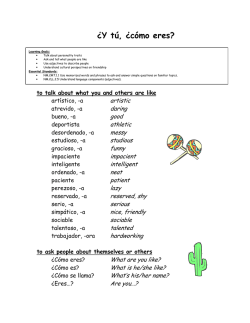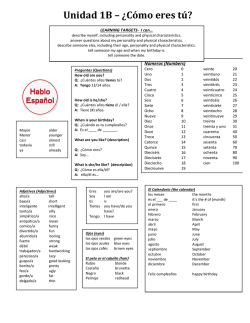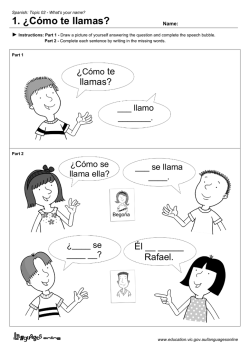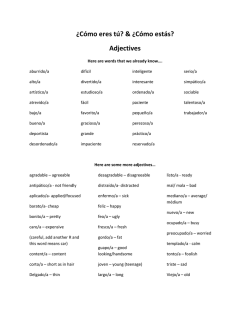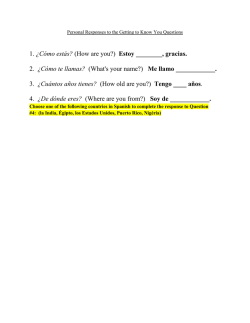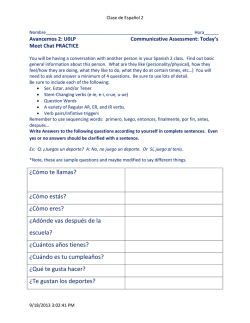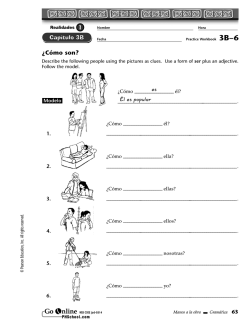
Practice and Communicate
sp04_te_xxxii_13.qxd 8/6/03 6:09 PM Page 2 Practice and Communicate Objectives • Talk about what you and other people are like • Tell where you and other people are from ivid Ac ad t Standards: xx ¿Comó eres tú? 1 •••••••••••••••• Presentation Xxx Resources: Audio Program: CD 1, Para empezar, Photo 1 #5202 Track 1 Focus: Reviewing personal characteristics and descriptions Suggestions: Use the Audio CD or have students perform the dialogues. Use gesture and over-acting to convey meaning. Use transparencies from Realidades 1 or the lists in the Gramática • Repaso and ¿Recuerdas? on p. 3 to review the adjectives that students have learned. Vary the dialogues with other adjectives. Alicia Sonia Gloria Enrique —Oye, Enrique, ¿eres artístico? —Sí, según mis amigos soy muy artístico y estudioso. También dicen que soy reservado. Y Gloria, ¿cómo eres tú? 1 Standards: 1.2 •••••••••••••••• 1. Enrique es muy artístico y estudioso. También es reservado. 2. Según sus amigos, Gloria es paciente y trabajadora. Según su hermanito, es impaciente y perezosa. 3. Sonia y Alicia son deportistas y también muy talentosas. 4. Felipe es muy sociable. Common Errors: Students may say that Gloria is pacienta, rather than paciente. Remind students that not all feminine adjectives end in -a. —¡Hola, Sonia y Alicia! ¡Uy! ¡Qué deportistas son Uds.! —Sí, somos muy deportistas y también muy talentosas. ¿Te gusta practicar deportes, Felipe? —Pues, no. No soy nada deportista, pero me gusta pasar tiempo con mis amigos. Soy sociable y muy simpático. tivid ad Resources: Practice Answers on Transparencies Focus: Reading comprehension Suggestions: Select four pairs of students to go to the board. Read the questions aloud, pausing after each to give the students time to answer by drawing pictures of the various characters. Call on students to answer the question orally and present their corresponding drawings. Have the class determine if the pictures on the board are accurate according to the dialogues. Answers: —Bueno . . . mis amigos dicen que soy paciente y trabajadora. Pero según mi hermanito, ¡soy impaciente y perezosa! Ac Ac ad tivid Felipe 1 Leer/Escribir/Hablar Los chicos Los chicos en las fotos de arriba hablan de cómo son. Usa las fotos y las conversaciones para contestar las preguntas. ¿Recuerdas? Here are some question words that are often used with ser: 1. ¿Cómo es Enrique? • ¿Quién(es)? 2. Según sus amigos, ¿cómo es Gloria? ¿Y según su hermanito? • ¿Cómo? • ¿De dónde? 3. ¿Cómo son Sonia y Alicia? 4. ¿Quién es sociable? 2 dos ¿Cómo eres tú?escolar Universal Access Block Schedule ••• •• • • • • • • • • • • • Cut out photos of people from magazines. Number them and post them around the room. Type up a handout that has a description to match each photo. Have students walk around the room and match the descriptions to the photos. Ask them to write an additional sentence for each photo’s description. 2 Advanced Learners Students with Learning Difficulties Have students go on a photo safari at your school, taking pictures of people demonstrating each trait reviewed here. They can print the pictures out and mount them on poster board, labeling each with a sentence identifying the trait, or use presentation software to create a slide show with graphics and narration. To help students grasp the gender and number distinctions underlying adjective agreement, make an overhead of the Gramática chart and add photos or drawings of males and females. For example, place one serious boy’s face beside serio and two serious boys’ faces beside serios. Give this to students as a handout. sp04_te_xxxii_13.qxd 8/6/03 6:09 PM Page 3 Practice and Communicate Adjectives Remember that adjectives describe people, places, and things. In Spanish, adjectives have the same number and gender as the nouns they describe and they usually come after the noun. Masculine Presentation Feminine Singular Plural Singular Standards: 4.1 Resources: Voc. & Gram. Transparencies: 21 Plural serio serios seria serias deportista deportistas deportista deportistas trabajador trabajadores trabajadora trabajadoras paciente pacientes paciente pacientes joven jóvenes* joven jóvenes Suggestions: Have two male students and two female students stand in front of the class. Make statements using different adjective forms (Es muy serio. Son trabajadores.). Have the rest of the class tell which students you could be talking about. Remind them that if the group is mixed you use the masculine plural form of the adjective. *Note that jóvenes needs an accent mark in the plural form. 2 ¿Recuerdas? Escribir/Hablar You already know these words to describe what you and your friends are like: 1. Según tus amigos, ¿cómo eres tú? ¿Artístico(a)? ¿Talentoso(a)? ¿Simpático(a)? alto, -a impaciente atrevido, -a inteligente 2. ¿Eres paciente o impaciente? ¿Eres trabajador(a) o perezoso(a)? bajo, -a ordenado, -a desordenado, -a reservado, -a 3. ¿Cómo es tu mejor amigo(a)? estudioso, -a sociable gracioso, -a viejo, -a tivid Standards: 1.3 Focus: Describing oneself and others Suggestions: Direct attention to the ¿Recuerdas? for more adjectives and review the meanings. Check comprehension by calling out adjectives and having students act them out. Answers will vary. Common Errors: Remind students to check the endings of the adjectives to be sure they agree with their subjects. Extension: Have students write a fourth question to ask a classmate, such as: ¿Cómo es tu hermano? ad tivid Ac 2 •••••••••••••••• guapo, -a 3 ad Y tú, ¿cómo eres? Ac Ac ad tivid Escribir ¿Cómo son? Trabajen en grupos para hacer una lista de ocho personas famosas. Luego usen los adjetivos de la Gramática y de ¿Recuerdas? y escriban una frase para describir a estas personas. Modelo Marc Anthony Marc Anthony es talentoso y muy guapo. Ac tres Para empezar 3 Enriching Your Teaching Have teams of students stand at a distance from you. Call out an adjective. Each team will send a student or students whom the adjective could describe. For example, for inteligente, they could send a boy or a girl, but for serio, they would have to send a boy. The first team to reach you with the correct answer wins a point. 3 Standards: 1.3 •••••••••••••••• El cantante Marc Anthony en concierto Teacher-to-Teacher ad tivid Culture Note Actors and singers from Spanishspeaking countries are crossing over to the American market and gaining popularity with English-speaking audiences. Their success is due in part to an increase in the Spanish-speaking population of the United States, which is expected to reach 70 million by 2020. Focus: Using adjectives to describe people Suggestions: Write on the board roles for carrying out group assignments, for example, expediter / leader, recorder, timekeeper, and spokesperson. Have students decide which roles the people in their group will perform as they work together on the activity. Make it clear to students if they should write the descriptive sentences as a group, or if you would like each student to write eight sentences about the famous people their group listed. Answers will vary. 3 8/6/03 6:09 PM Page 4 tivid ad Practice and Communicate Ac sp04_te_xxxii_13.qxd 4 Leer/Escuchar Dos jóvenes Ac ad tivid 4 Standards: 1.2 Lee esta descripción de dos chicas latinoamericanas. Luego escribe los números del 1 al 6 en una hoja de papel. Escucha las frases y escribe C si la información es cierta y F si es falsa. •••••••••••••••• Nombres: Alicia Menéndez García y Carmen Díaz Ortiz Edades: Tienen 18 años. Residencia: Viven en Santiago de los Caballeros, República Dominicana, con sus familias. Cómo son: Alicia es una poeta joven. Lee sus poemas en público. Ella es muy inteligente y artística. Carmen no es artística pero le gusta escuchar los poemas de Alicia. Carmen es muy sociable y deportista. Las dos jóvenes son amigas inseparables. Amigos: “Nuestros amigos son graciosos y simpáticos,” dicen Alicia y Carmen. “No tenemos tiempo para las personas negativas.” Resources: Audio Program: CD 1, Para empezar, Track 2; Resource Book: Para empezar, Audio Script; Practice Answers on Transparencies tivid ad 1. Alicia y Carmen tienen 18 años. (C) 2. Alicia es de Puerto Rico, y Carmen es de Cuba. (F) 3. Alicia es poeta. (C) 4. Carmen es muy sociable. (C) 5. A Carmen no le gusta escuchar los poemas de Alicia. (F) 6. Los amigos de las jóvenes son negativos y serios. (F) Ac Focus: Listening comprehension Suggestions: Can students guess the meaning of edades? Ask students questions about the reading to give them practice locating the information before you play the Audio CD. Script and Answers: 5 Escribir ¿Y cómo son tú y tus amigos? Ahora escribe una descripción de tu mejor amigo(a) y de ti. Usa la información de la descripción en la Actividad 4: nombres, edades, residencia y cómo son. Ac ad 5 Ac tivid Standards: 1.3 •••••••••••••••• Focus: Writing descriptions of oneself and others Suggestions: For the Cómo son section, have students create two cluster diagrams to organize their ideas, one about themselves and one about their friend. Answers will vary. Ac ad tivid 6 Writing, Audio & Video Workbook: CD1, Para empezar, Audio Activity 1, Track 3 • Writing, Audio & Video Workbook: Para empezar, Writing Activity 4 • 4 Leer/Escribir/Hablar Lee la conversación entre los dos chicos del dibujo. Imagina lo que dicen las chicas sobre los chicos. Escribe la conversación de las chicas usando la conversación de los chicos como modelo. Presenta la conversación a la clase. Esas chicas son muy bonitas. ¿Sabes cómo se llaman, Carlos? Sí, hombre. Se llaman Dolores y Marisa. Son de Buenos Aires. •••••••••••••••• Additional Resources 6 Amigos y primos Standards: 1.2, 1.3 Focus: Using a visual prompt for writing Suggestions: Check comprehension by asking why Carlos’s friend has a surprised expression in the last frame of the comic strip (he didn’t know that Carlos and the girls were cousins). Then brainstorm as a class what the girls might be saying. Remind students that the girls are Carlos’s cousins, so their conversation will be different from the one in the comic strip. Answers will vary. ad tivid Las dos son simpáticas. Dolores es seria y reservada. Le gusta leer. Marisa es graciosa y muy sociable. Le gusta pasar tiempo con sus amigos. Más práctica Practice Workbook P-1 4 ¿Uds. son muy buenos amigos? ¿Cómo son? Pues, sí, pero también somos primos. For: Practice with adjectives Visit: www.phschool.com Web Code: jdd-0001 cuatro ¿Cómo eres tú?día escolar Universal Access Multiple Intelligences Students with Special Needs Visual / Spatial: Have students treat Actividad 5 as if it were a magazine article. They should include a photo, write a title for the interview, and type the interview to look like it came from a magazine. They should boldface the headings nombres, edades, etc., and of course, include a byline. Using the script for Actividad 4, create a chart for hearing impaired students. In the first column, list the dictated sentences describing Alicia and Carmen. In the second column, have students write C for cierta if the information is true. If it is false, have them rewrite the sentence with correct information. sp04_te_xxxii_13.qxd 8/6/03 6:09 PM Page 5 Practice and Communicate The verb ser You have learned to use the verb ser with adjectives to tell what someone is like. Remember that ser is irregular. Here are its present-tense forms: Esas chicas son bonitas. You have also learned to use ser with de to tell where someone is from. Son de Buenos Aires. (nosotros) (nosotras) somos (tú) eres (vosotros) (vosotras) sois Ud. (él) (ella) es Uds. (ellos) (ellas) son Presentation tivid Así son los compañeros de Alejandro Escribe la forma correcta del verbo ser para completar lo que Alejandro escribe sobre los estudiantes en su clase de español. Escribir ¿Y cómo son tus compañeros? ¿Cómo son los estudiantes en tu clase de español? Usa la descripción de Alejandro como modelo y escribe cinco o seis frases para describir a tus compañeros. 9 tivid ad tivid ad 7 Standards: 1.2 •••••••••••••••• Escribir/Hablar Juego Tu profesor(a) te va a dar una tarjeta con el nombre de otro(a) estudiante de la clase. Escribe una descripción de esta persona en la tarjeta. Luego vas a leer la descripción y tus compañeros tienen que adivinar (guess) quién es. Resources: Practice Answers on Transparencies Focus: Using the present-tense forms of ser to complete a paragraph Suggestions: Point out to students that in this activity the adjectives will help them decide which form of ser to use. Answers: 1. es 2. son Modelo Es seria y trabajadora, pero muy simpática. Le gusta la música. Ella e Isabel son buenas amigas. ¿Quién es? Más práctica Practice Workbook P-2 ad tivid Ac Así son los estudiantes en mi clase de español. Ana María 1. estudiosa y le gusta mucho leer. Manuel y Marianela practican muchos deportes y 2. deportistas. A José Luis le gusta nadar en la piscina grande en el gimnasio; él 3. atrevido. A mi compañero Juanito y a mí nos gusta ir a la escuela porque nosotros 4. trabajadores. Pero a Mercedes y a Eduardo no les gusta ir a la escuela porque 5. perezosos. Carolina dibuja bien y 6. muy artística. Manolito y Victoria tocan la guitarra y 7. muy talentosos. A mi compañero Ignacio y a mí nos gusta mucho hablar por teléfono y pasar tiempo con amigos porque 8. sociables. Pero a mí no me gusta ir al gimnasio porque no 9. deportista. Y tú, ¿cómo 10. ? 8 Resources: Voc. & Gram. Transparencies: 22 Suggestions: Bring a light bulb to class. Hold the light bulb over your head and say ¡Soy muy inteligente! ¡Tengo muchas buenas ideas! Have a student stand under the lightbulb with you and say ¡Somos inteligentes! Hold the light bulb over other students’ heads to present the other forms of ser. You might also want to show the GramActiva Video on ser from Realidades 1, Capítulo 3B as a review. Estar will be reviewed in Capítulo 2A. Ac Leer/Escribir Ac Gramática Ac 8 3. es 4. somos 5. son 6. es 7. son 8. somos 9. soy 10. eres Standards: 1.3 •••••••••••••••• For: More practice with ser Visit: www.phschool.com Web Code: jdd-0002 cinco Para empezar Enriching Your Teaching Have students bring in props or costumes identified with the various adjectives. Have an “adjective parade” in which students walk in front of the class while the others call out statements: Es deportista. Es inteligente. Students can then group themselves with others who have chosen the same adjective and repeat the parade. Culture Note Santiago de los Caballeros, mentioned in Actividad 4, is the second largest city in the Dominican Republic. Founded in the 1490s by members of Columbus’ second expedition to the Americas, it is often referred to simply as “Santiago.” The city is known for its beauty and for its vital manufacturing industry. tivid ad Teacher-to-Teacher 5 Focus: Using ser to describe people Suggestions: Write Así son los estudiantes en mi clase de español on the board. Brainstorm the subjects and descriptions students could use. Answers will vary. Ac Ac 7 soy ad ad tivid (yo) 9 Standards: 1.3 •••••••••••••••• Focus: Describing people Suggestions: Prepare the cards in advance. Read each student’s description before it is read aloud to make sure there are no inappropriate descriptions. Answers will vary. 5 sp04_te_xxxii_13.qxd 8/6/03 6:12 PM Page 6 Practice and Communicate Exploración del lenguaje Nationalities You have already learned many adjectives of nationality. The Spanish words for these nationalities are based on the country name. Review the chart to see how each nationality relates to the country of origin. Remember that since the nationalities are adjectives, they agree in gender and number with the nouns they describe. They are usually used with the verb ser. Exploración del lenguaje Presentation Resources: Voc. & Gram. Transparencies: 23 Focus: Reviewing adjectives of nationality Suggestions: Have students choose 16 of the countries listed in Exploración del lenguaje and write them on a sheet of paper in a four-by-four grid. Play “Bingo” by calling out the names of countries randomly. Students will place a check by the countries they hear. Students who check off four in a row and call out “Bingo!” will win that round only if they correctly say the male and female nationalities of all the countries in that row. Nacionalidad País •••••••••••••••• argentino, -a Paraguay paraguayo, -a boliviano, -a España español, española Perú peruano, -a Chile chileno, -a Guatemala guatemalteco, -a Puerto Rico puertorriqueño, -a Colombia colombiano, -a Honduras hondureño, -a Costa Rica costarricense México mexicano, -a República dominicano, -a Dominicana Cuba cubano, -a Nicaragua nicaragüense Uruguay uruguayo, -a Ecuador ecuatoriano, -a Panamá panameño, -a Venezuela venezolano, -a Bolivia 10 Leer/Escribir Una población diversa Resources: Practice Answers on Transparencies Focus: Summarizing information from a chart; cross-curricular connection to social studies Suggestions: Tell students that when they write a summary of a paragraph they are expected to describe its main ideas. The same is true when summarizing information in a chart or graph. Help students identify the main ideas of the chart before they begin to write. Model commentary for them that they can then use in creating their summaries. Answers will vary. Extension: Have pairs of students work together to create a list of cognates in the introductory paragraph and the chart. Los Estados Unidos es un país de inmigrantes, donde hay gente de todas partes del mundo. Un grupo importante de los inmigrantes está formado por hispanohablantes. La población hispana representa más de 35 millones de personas, o el 13 por ciento (percent) de la población total. Es muy diversa porque hay hispanohablantes de muchos países hispanos. Lee la gráfica sobre esta población y escribe un resumen. Block Schedule 6 ••• •• • • • • • • • • • • • Distribute a photocopied map of Central and South America that does not have the countries or cities labeled on it. You could also use an overhead of the same map. As a class, fill in the country names of all the Spanish-speaking countries, as well as their capitals and important cities. Ask students to pick a country and tell the class that they are from a city in that country. Tell them to mention their new nationality. 6 Nacionalidad salvadoreño, -a tivid Standards: 1.2, 1.3, 3.1 Ac Ac 10 País Nacionalidad El Salvador ad ad tivid País Argentina Modelo El grupo más grande de hispanohablantes en los Estados Unidos es el grupo de México. Los mexicanos son el 58.5 por ciento . . . Bar graph TK 5171 insert bar graph here seis ¿Cómo eres tú?a 1 • Tu día escolar Universal Access Multiple Intelligences Students with Learning Difficulties Verbal / Linguistic: Photocopy the nationalities chart and distribute to students. Have students analyze the chart to form general rules about how nationality adjectives are formed. Have them color-code the different forms and then come up with general rules and exceptions. For Actividad 10, make a transparency of the Conexiones. Explain that a bar graph presents information in a visual format, making comparisons more apparent. Ask questions to highlight facts, for example: Among the countries listed, which is least represented in the United States? 8/6/03 6:14 PM Page 7 Practice and Communicate Ac ad tivid 11 Hablar ¿De dónde son? Modelo estadounidense Estados Unidos Juanita, La Habana José, Tegucigalpa Cuba 20 (maps); Practice Answers on Transparencies Focus: Asking and telling where someone is from Suggestions: Call out the names of the cities the students in the activity are from and have students guess the countries without looking at their books. Point out that Mexicans are also North Americans, so the adjective estadounidense is used to specify an “American” from the United States. Answers: norteamericano, -a North American (including Canada, Mexico, and the United States) Ricardo, Santo Domingo canadiense Canadian Venezuela Panamá Colombia Linda, Caracas Ecuador Sergio, Madrid Juanita es de La Habana. Es cubana. José es de Tegucigalpa. Es hondureño. Ricardo es de Santo Domingo. Es dominicano. Linda es de Caracas. Es venezolana. Teresa es de Asunción. Es paraguaya. Benjamín es de Montevideo. Es uruguayo. Esteban es de Lima. Es peruano. Mercedes es de la Ciudad de Panamá. Es panameña. Sergio es de Madrid. Es español. María José es de Madrid. Es española. España Perú Mercedes, La Ciudad de Panamá Bolivia Paraguay Teresa, Asunción Chile María José, Madrid Uruguay tivid Ac Argentina 12 Benjamín, Montevideo Ac ad Hablar ¿Y de dónde eres tú? Modelo Imagina que eres de uno de los países hispanohablantes que está en el mapa de la Actividad 11. Con otro(a) estudiante, pregunta y contesta según el modelo. Más práctica Practice Workbook P-3 Standards: 1.1 •••••••••••••••• tivid 12 ad Esteban, Lima Standards: 1.1 Resources: Voc. & Gram. Transparencies: 12–18, U.S. citizen República Dominicana Puerto Rico Guatemala Honduras El Salvador Nicaragua Costa Rica 11 •••••••••••••••• Para decir más . . . México tivid ad A —¿De dónde es Teresa? B —Es de Asunción. Es paraguaya. Estos estudiantes le escriben a tu clase por correo electrónico. Trabaja con otro(a) estudiante y pregúntale de dónde es cada estudiante y de qué nacionalidad. Después de hablar de estos chicos, pregunta a tu compañero(a) de dónde es. Ac sp04_te_xxxii_13.qxd A —¿De dónde eres tú? B —Soy de San Juan. A —Ah, eres puertorriqueño(a). For: More practice with nationalities Visit: www.phschool.com Web Code: jdd-0003 siete Para empezar 7 Enriching Your Teaching Focus: Asking and telling where someone is from Suggestions: Have students imagine that they are having the conversation in the activity with a stranger on an airplane. Place three chairs in a row at the front of the room and have volunteers perform their conversations for the class. You will be the flight attendant. Answers will vary. Common Errors: Students may say ¿Dónde eres tú? Remind them that they must use de dónde to ask where some one is from. Additional Resources Writing, Audio & Video Workbook: CD1, Para empezar, Audio Activity 2, Track 4 • Writing, Audio & Video Workbook: Para empezar, Writing Activity 5 • Teacher-to-Teacher Have a group of students draw the flag of each Spanish-speaking country on white index cards (see El mundo hispano on pp. xvi–xxvi). On the back, they will write each country’s name and nationality upside down. Tape the flags on the bulletin board. Students can guess the countries and nationalities, then flip up the flag to see if they are correct. Culture Note There are roughly 414 million Spanish speakers worldwide: United States—35 million; Spain—40 million; Central America—38 million; Mexico—103 million; South America—178 million; Caribbean nations—20 million. 7
© Copyright 2024
